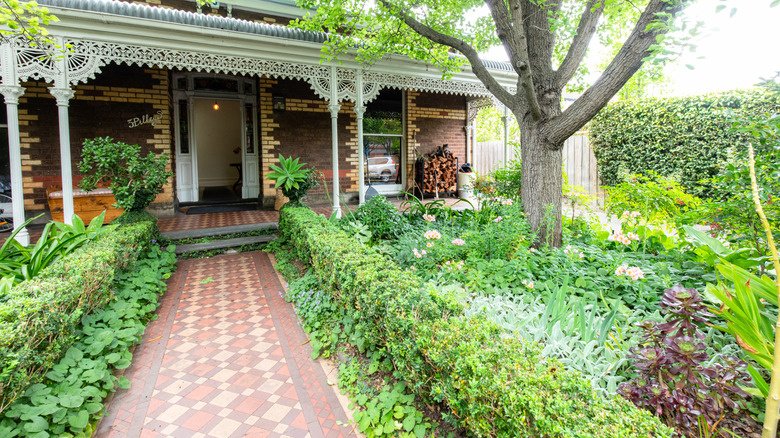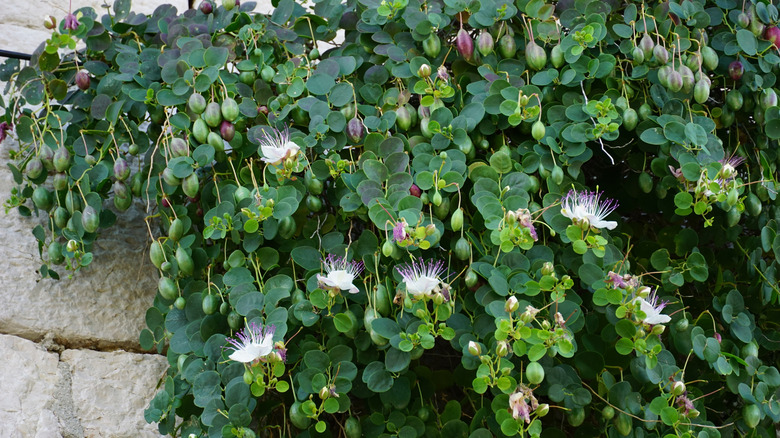Boost Your Front Yard Landscaping With A Low-Maintenance Flowering Bush
A low-maintenance front yard is a dream for homeowners and certainly something to aspire to. Apart from following a few genius tips for landscaping your front yard, you can make it even more special by selecting interesting plants that require minimal care but also add some vibrancy. If you live in USDA hardiness zones 8 through 10, there's quite a stunning Mediterranean perennial you might want to grow to give a boost to your front yard landscaping. This low maintenance flowering shrub is commonly known as the caper bush — and yes, it's the plant that produces those delicious little morsels that are often used to add some zing to Italian dishes.
The caper bush (Capparis spinosa) is a relatively low-growing shrub only reaching a maximum height of around 3 feet, but its spreading branches can reach a width of up to 6 feet. It puts on a magnificent display when the flowers appear in spring and continue on through summer and into the fall. The showy white blooms are fragrant and their appearance is enhanced by the multitude of purple stamens that protrude from the center of the four large petals. Sadly, each flower only lasts for one day, but the plant blooms profusely for many months. Even when not in bloom, the shrub is quite attractive with its thick fleshy green leaves that have hooked spines at the base of the petiole. Best of all, this plant is extremely drought-tolerant once established, making it absolutely perfect for your low-maintenance front yard landscaping.
How to grow caper bush in your front yard
The caper bush thrives really well in hot climates and can go for prolonged periods without additional watering due to its fleshy leaves. In Mediterranean countries such as Italy, the plant is often found growing in stone walls, rock crevices, and even cracks in roads. This alludes to the fact that it prefers plenty of sunshine and doesn't need constant pampering. If you want to grow the caper bush in your front yard, choose a sunny spot that drains well. It will actually thrive in poor or sandy conditions, and doesn't mind rocky ground. That's good news if your front yard doesn't have the best soil, and don't forget that poor soil quality is no problem when growing a range of other beautiful plants.
When first planted, it's recommended to water your young shrub once the top two inches of soil are dry. However, once your caper bush has settled into its new home, refrain from giving it any extra water unless you're experiencing a really long spell of dry weather. Your plant should generally survive on rainfall alone, but if you're concerned, test the top 4 inches of soil and only water if it is dry. When planted in most garden soils, your caper bush shouldn't require any additional fertilizer. Don't worry if the plant loses its leaves in the winter because it can be deciduous, if you live in a slightly colder zone.
A few tips on pruning and harvesting
Although the caper bush is entirely low-maintenance, it does produce its flowers on new growth. For this reason, you may want to prune the spreading branches quite hard in winter as this will encourage lots of new growth in the spring. Bear in mind that it can take around three to four years for your shrub to actually start flowering, depending on its age when you planted it.
Growing a caper bush in your front yard might have you wondering about edimentals and what you need to know about this garden trend. Even though you'll probably only be growing this species for its ornamental value and minimal maintenance requirements, you might like to try harvesting and making your own capers. The capers are the unopened flower buds that you want to harvest when they're about pea-sized. These then need to be pickled or preserved to make them edible. But that's not the only harvest you can get from this plant. After flowering, oblong fruits are formed, commonly known as caper berries. These can be harvested when they're about 2 to 3 inches long and also need to be pickled before consuming. You should note that both the buds and berries can't be eaten raw because they're filled with mustard oil, which gives them a bitter flavor, but pickling helps to make them more palatable.


